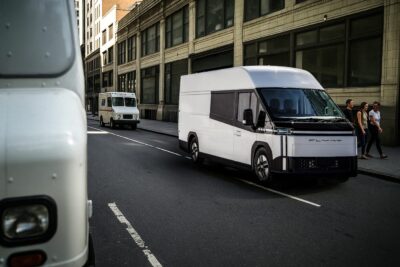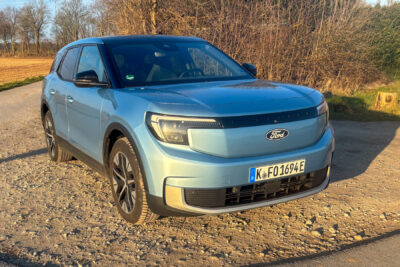
ACEA: 1.8 per cent of cars in the EU were electric in 2023
The European industry association ACEA has published a report on the number of vehicles on the road. It is important to note that even though the report was published in February 2025 and, according to the cover, is dated January 2025, the data on the number of vehicles does not refer to the end of 2024 but to 2023. That means there is a whole year’s worth of new registrations missing – 2024 was not an easy year for electric cars, but the figure for new EV registrations was still 13.6 per cent, while diesel cars only accounted for 11.9 per cent.
Now to the data on the existing fleet: according to the report, a total of 1.8 per cent of cars in the EU were fully electric in 2023, 1.1 per cent of vans, 0.1 per cent of trucks and 2.5 per cent of buses. To put that into perspective: There were 249 million cars on EU roads, 30.1 million vans, six million trucks, and 680,000 buses.
Let’s stick with cars for a moment: Besides the 1.8 per cent BEVs, 2.1 per cent plug-in hybrids hit the road in 2023, meaning that 3.9 per cent of the car fleet could be charged externally. It shows growth, albeit at a low level: in the 2022 statistics, it was still 2.2 per cent. 3.2 per cent of the passenger car population are declared as hybrids, whereby the ACEA also counts mild hybrids, which cannot drive purely electrically or can only drive extremely short distances. In other statistics, such as Jato Dynamics, mild hybrids are considered combustion engines.
Denmark has the largest share of electric cars in the EU
Among EU countries, Denmark has the highest proportion of BEVs on the road with 7.1%, followed by Sweden (5.9%), Luxembourg and the Netherlands (each 4.9%). According to ACEA statistics, Germany is above the EU average at 2.9 per cent. However, many other countries still have some catching up to do: Italy, Croatia, Cyprus, the Czech Republic, Poland, Romania, Slovakia, and Greece are at 0.5 per cent or below – Spain is only just above this mark with 0.6 per cent.
EFTA countries and the UK show that things can be done differently: Iceland (11.0%), Norway (24.2%), Switzerland (3.2%) and the UK (2.9%) are all well above the EU average of 1.8 per cent. “The report demonstrates that while legislative targets can help steer change, this is only one small part of the puzzle that is the decarbonisation of road transport,” the ACEA writes.”Europe needs a realistic pathway to decarbonising the automotive industry. The transformation in Europe is not progressing at the pace required.”
A look at the statistics on vehicle age also shows that it will be quite some time before electric drives reach a double-digit share of the vehicle population: the EU average is 12.5 years old, compared to 10.3 years in Germany. Although some countries with a higher proportion of EVs tend to have a younger fleet (Denmark, for example, 9.6 years), this is not necessarily the case. In Norway, the average age is 11.1 years, which shows that the switch to electric cars was promoted earlier and more consistently there.
Conversely, the relatively low figures for electric drives mean that combustion engines still predominate: 50.0 per cent of the EU’s fleet is made up of petrol cars, and 39.5 per cent of diesel cars – petrol cars are generally still in the lead when it comes to new registrations. Still, the number of diesel cars has dropped to 11.9 per cent, as mentioned above. It is thus only a matter of time before diesel vehicles also lose ground. The ACEA also differentiates between natural gas (0.6 per cent) and LPG (2.6 per cent). Fuel cell cars are not mentioned separately, but are listed under ‘Other’ (0.1 %) or ‘Unknown’ (0.2 %).
In the EU, diesel vans clearly dominate – accounting for 90.5 per cent of the fleet. The EU average for petrol vans is 5.9 per cent, although some Eastern European countries and Greece still have double-digit shares. Among the alternative drive systems, only battery-electric vehicles account for more than one per cent, with all others below this figure. However, electric drives are also still struggling in terms of new registrations, as the latest statistics for 2024 show.
Electric buses are on the rise
Unsurprisingly, diesel is also the predominant drive type among the six million trucks, accounting for 96.4% of the total. Here, petrol engines (0.6%) are surpassed by natural gas engines (0.8%). Battery-electric vehicles are in their infancy here, as the registration figures for 2024 also show. At the end of 2023, they accounted for 0.1 per cent of the total market.
The situation is somewhat different for buses. Public service buses, in particular, travel on predictable routes in a fixed area, so their deployment and charging infrastructure can be better planned. Historically, diesel is still far ahead here, accounting for 89.2 per cent of the total. Electric buses still have a lot of catching up to do, as they only have a market share of 2.5 per cent. In four EU countries, however, they are already in the double-digit range – in Denmark with 10.8 per cent, Ireland with 13.5 per cent, Luxembourg with 14.7 per cent and in the Netherlands it is already 17.7 per cent. And not in terms of new registrations, but in terms of existing vehicles.
Some of the bus statistics clearly show the different subsidy approaches of the countries: Ireland has the aforementioned 13.5 per cent share of electric buses and 4.1 per cent of hybrid buses, but 0.0 per cent of gas-powered buses. On the other hand, Estonia has 0.0 per cent electric buses, but 1.2 per cent hybrids and 19.0 per cent natural gas. France is close to the EU average, with electric buses accounting for 2.4 per cent of the total fleet, but it also has 3.8 per cent hybrids and 8.1 per cent natural gas buses. With 3.1 per cent of its fleet made up of electric buses, Germany is slightly above the EU average.




0 Comments